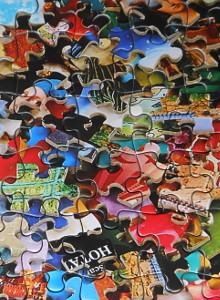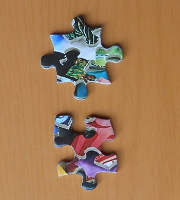Chit-chat from Imaginatorium Shop
Ultimate challenge?
Blog entry for March 2019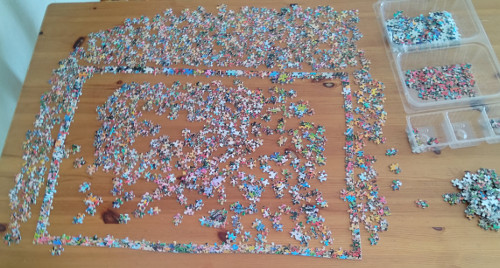
There is an interesting range from Beverly of "Puzzler's puzzles," just chosen to be different or difficult. The latest they have called "Jigsomania" (the way "Jigsaw" is written in Japanese looks like ji-gu-so-o, hence the 'o'), consisting simply of a photograph of a pile of jigsaw puzzle pieces. I did the 1000-piece version; there is also a 300-piece.
SpoilerWell, not really quite a spoiler, because there is no simple solution! But here are some hints on cracking this one...
Technically the photograph in this puzzle is a bit of a disaster. You would have thought the art department would be given the job of making a nice pile of pieces, then reproducing it "flat" – with the axis of the lens perpendicular to the subject, and appropriate lens and aperture to make it crisply in focus everywhere. (Just as if you put the pieces upside down on a photocopier.) But this looks rather as if someone said "No need for anything technical; my phone's got eight squillion pixels..." The result is that very little of the image is even in focus, and it was taken at an angle, with a wide-angle lens, so the bottom corners in particular are totally blurred.
The counter argument would have to be that someone could see how hard the puzzle would be, and thought they would offer some clues. There are actually two ways in which it is easier: identifying the degree of blur tells you a lot about where the piece might go, and the viewing angle means that for almost any piece, you can immediately see which way up it goes. The latter is extremely unusual: for most "hard bits", the sky for example, you can at least look at the paper grain on the back of the piece to see if it is vertical or horizontal, but when trying a piece you automatically check whether it might go in upside down. I found myself having to consciously avoid wasting time doing this!
So here's my suggested best strategy:
You will need lots of space to keep the groups of connected pieces, and it hardly needs saying that you will need enormous reserves of patience. Good luck! ... photo of completed puzzle follows shortly - once I have it framed! |
"A kind of blog..." My sporadic comments, mostly topical, on shop matters. (Brian Chandler)
|

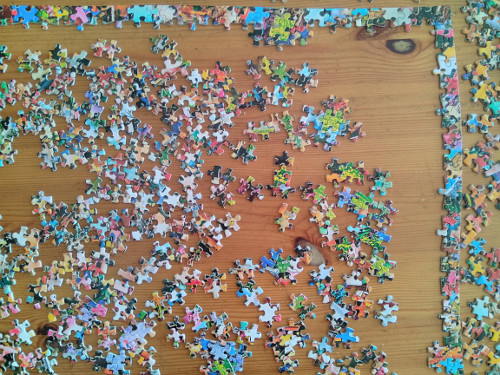 I don't normally look at the box ("cheating"!) and I don't normally start with the edge pieces, as I enjoy watching the picture emerge from chaos. But here it is all but impossible to sort the pieces by basic area - the sky pieces, the grass, the boat, and so on - so I settled on the edge pieces first. This didn't actually take too long, but then the real struggle begins. I would go through the pieces, choosing some distinctive colour, and just try to find any pair of pieces that fitted together. Ever so gradually, bits got joined together; but unlike a normal puzzle, where there are always coherent areas of the same texture, here the pieces just joined in random squiggly clusters.
I don't normally look at the box ("cheating"!) and I don't normally start with the edge pieces, as I enjoy watching the picture emerge from chaos. But here it is all but impossible to sort the pieces by basic area - the sky pieces, the grass, the boat, and so on - so I settled on the edge pieces first. This didn't actually take too long, but then the real struggle begins. I would go through the pieces, choosing some distinctive colour, and just try to find any pair of pieces that fitted together. Ever so gradually, bits got joined together; but unlike a normal puzzle, where there are always coherent areas of the same texture, here the pieces just joined in random squiggly clusters.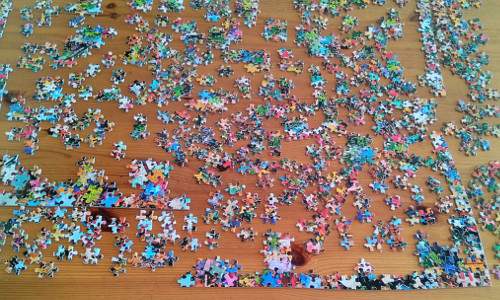 Keep going...
Keep going...
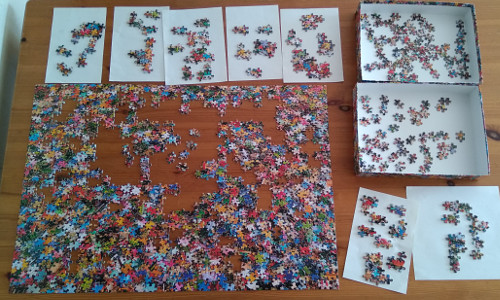 Although I ended up with several large "lumps", connected pieces with no connection to the edges, curiously the corners definitely filled in first. I'll leave the explanation of this to the "spoiler" box below.
Although I ended up with several large "lumps", connected pieces with no connection to the edges, curiously the corners definitely filled in first. I'll leave the explanation of this to the "spoiler" box below.
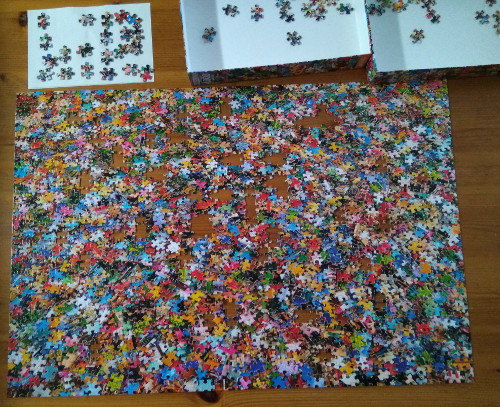 And eventually it was just a question of filling in the holes. (Sorry, I would have put the puzzle on a more contrasting colour if I had thought more carefully about photography!)
And eventually it was just a question of filling in the holes. (Sorry, I would have put the puzzle on a more contrasting colour if I had thought more carefully about photography!)